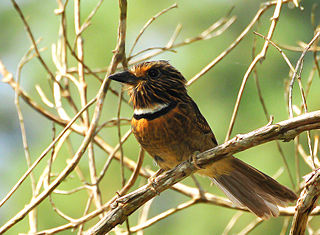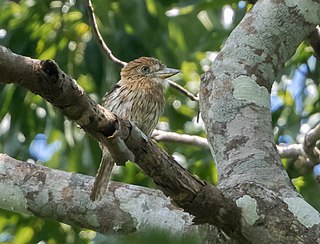
The russet-throated puffbird is a species of near-passerine bird in the family Bucconidae, the puffbirds, nunlets, and nunbirds. It is found in Colombia and Venezuela.

The two-banded puffbird is a species of near-passerine bird in the family Bucconidae, the puffbirds, nunlets, and nunbirds. It is found in Colombia and Venezuela.

The collared puffbird is a species of bird in the family Bucconidae, the puffbirds, nunlets, and nunbirds. It is found in Bolivia, Brazil, Colombia, Ecuador, French Guiana, Guyana, Peru, Suriname, and Venezuela.

The sooty barbthroat is a hummingbird species in the family Trochilidae. It is found in Brazil and French Guiana.

The chestnut-capped puffbird is a species of bird in the family Bucconidae, the puffbirds, nunlets, and nunbirds. It is found in Bolivia, Brazil, Colombia, Ecuador, Peru, and Venezuela.

The spotted puffbird is a species of puffbird in the family Bucconidae, the puffbirds, nunlets, and nunbirds. It is found in Bolivia, Brazil, Colombia, Ecuador, French Guiana, Guyana, Peru, Suriname, and Venezuela.

The black-streaked puffbird is a species of near-passerine bird in the family Bucconidae, the puffbirds, nunlets, and nunbirds. It is found in Bolivia, Colombia, Ecuador, and Peru.

The crescent-chested puffbird is a species of near-passerine bird in the family Bucconidae, the puffbirds, nunlets, and nunbirds. It is endemic to Brazil.

The grey-cheeked nunlet is a species of near-passerine bird in the family Bucconidae, the puffbirds, nunlets, and nunbirds. It is found in Colombia and Panama.

The rufous-capped nunlet is a species of near-passerine bird in the family Bucconidae, the puffbirds, nunlets, and nunbirds. It is found in Bolivia, Brazil, and Peru.

The pied puffbird is a species of bird in the family Bucconidae, the puffbirds, nunlets, and nunbirds. It is found in Bolivia, Brazil, Colombia, Costa Rica, Ecuador, French Guiana, Guyana, Nicaragua, Panama, Peru, Suriname, and Venezuela.

The Caatinga puffbird is a species of bird in the family Bucconidae, the puffbirds, nunlets, and nunbirds. It is endemic to Brazil.

The eastern striolated puffbird is a species of bird in the family Bucconidae, the puffbirds, nunlets, and nunbirds. It is found in Bolivia and Brazil.

The ivory-billed aracari or ivory-billed araçari is a near-passerine bird in the toucan family Ramphastidae. It is found in Brazil, Colombia, Ecuador, Peru, and Venezuela.

The pale-mandibled aracari or pale-billed araçari is a near-passerine bird in the toucan family Ramphastidae. It is found in Ecuador and Peru.

The brown-mandibled aracari is a near-passerine bird in the toucan family Ramphastidae. It is found in Bolivia, Brazil, and Peru.

The black-throated toucanet is a near-passerine bird in the toucan family Ramphastidae. It is found in Bolivia, Brazil, Ecuador, and Peru.

Wagler's toucanet is a species of bird in the toucan family Ramphastidae. It is endemic to southwestern Mexico.

The western striolated puffbird is a species of bird in the family Bucconidae, the puffbirds, nunlets, and nunbirds. It is found in Bolivia, Brazil, Colombia, Ecuador, and Peru.

The Chaco puffbird is a species of bird in the family Bucconidae, the puffbirds, nunlets, and nunbirds. It is found Argentina, Bolivia, Brazil, and Paraguay.






















